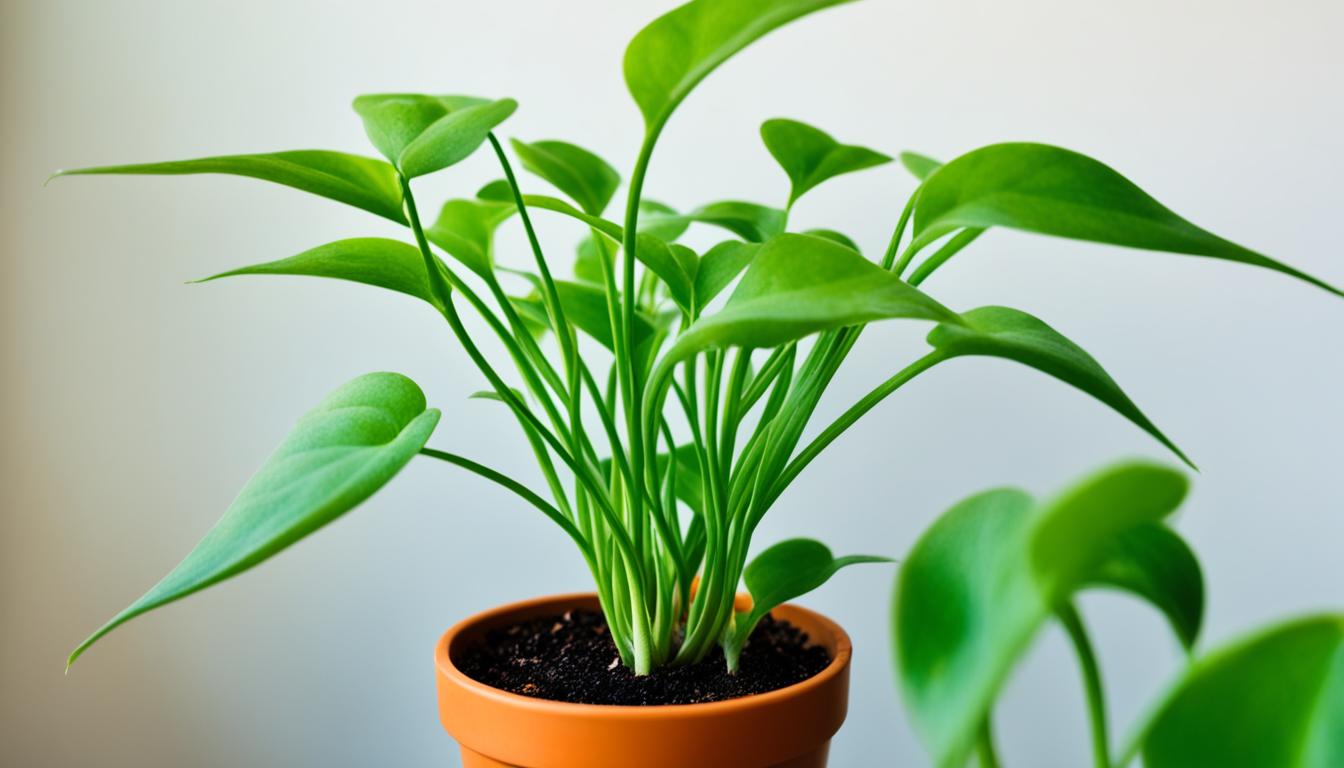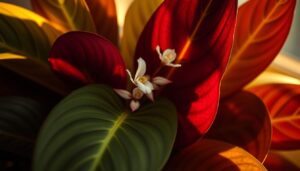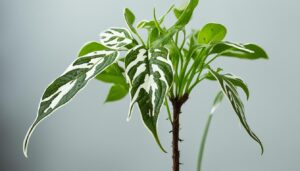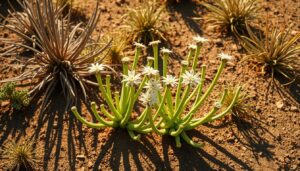Have you ever seen your indoor plants with curled leaves? This can be frustrating and make you wonder what’s wrong. This guide will help you figure out why your leaves are curling and how to fix it.
What causes leaves to curl? Is it from not enough water, or something more complex? Let’s explore the reasons and solutions together. We’ll help you fix your plants and make them healthy again.
Underwatering: The Primary Culprit
One of the main reasons indoor plants’ leaves curl is underwatering. Plants need enough water to stay strong. Without it, they curl their leaves to save moisture. This can be tough for plant owners, but knowing how to spot and fix underwatering can help.
Signs of Underwatering
Spotting underwatering signs is crucial. Look for these key signs:
- Dry, crispy leaves
- A wilted, drooping appearance
- A dry, cracked soil surface
How to Revive an Underwatered Plant
If your plants look dehydrated, act fast to rehydrate them. Here are some good watering techniques to use:
- Water the plant well until the soil is soaked and water flows out of the pot’s bottom.
- Try the capillary action method by putting the plant’s pot in a water-filled container. Let it soak up moisture.
With the right watering techniques, you can bring an underwatered plant back to life. It will look healthy and vibrant again.
“The key to reviving an underwatered plant is to rehydrate it slowly and thoroughly, allowing the soil to absorb the moisture it needs.”
Overwatering: A Surprising Cause
Overwatering can cause your indoor plants to curl their leaves. When plants get too much water, their roots rot because they can’t breathe. This stops them from getting the nutrients and water they need. So, the leaves curl up to protect themselves from losing more water.
Recognizing Overwatered Plants
It’s important to know when your plant is getting too much water. Here are signs to watch for:
- Yellowing or wilting leaves
- Soggy, waterlogged soil
- A foul, musty odor coming from the pot
Restoring Overwatered Plants
If you think your plant is overwatered, act fast. Here’s how to help it:
- Carefully remove the plant from its pot
- Trim off any damaged or rotting roots
- Repot the plant in a well-draining potting mix
- Adjust your watering schedule to allow the soil to dry out slightly between waterings
Fixing the issue of overwatering can save your plant. It can also stop root rot. Knowing how to identify overwatered plants and treating overwatered plants right is key to keeping your plants healthy.
indoor plant leaves curling: Environmental Factors
Improper watering is often the main cause of indoor plant leaves curling. But, environmental factors also play a big part. Things like low humidity, heat stress, and lighting issues can cause this problem.
Low Humidity and Heat Stress
Low humidity and high temperatures make plants lose moisture too fast. This can lead to leaf curling. If your indoor plants are dealing with low humidity or heat stress, here’s what you can do:
- Regularly mist your plants with a spray bottle to increase humidity around them.
- Use a pebble tray filled with water to create a more humid microclimate.
- Invest in a small humidifier to maintain optimal moisture levels.
- Move your plants to a cooler location and provide shade during the hottest parts of the day.
Lighting Issues: Too Much or Too Little
Not enough or too much light can stress your indoor plants, causing leaf curling. Here’s how to fix lighting issues:
- Gradually acclimate your plants to brighter conditions to prevent leaf scorch.
- Provide more light for plants that seem to be stretching or becoming leggy (a sign of low light).
- Ensure your plants are getting the right amount of light for their needs and adjust as needed.
Remember, proper plant acclimation is crucial when changing environmental conditions to protect your indoor plants.
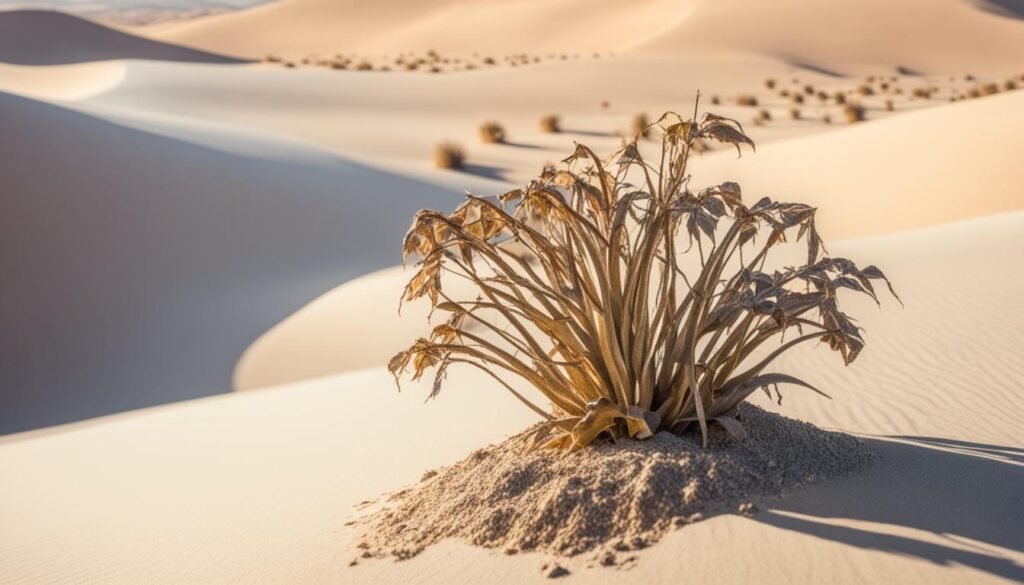
Pest Infestations and Diseases
Pest infestations and plant diseases can make your indoor plants curl their leaves. Pests like aphids, spider mites, mealybugs, and scale insects eat the plant’s sap. This weakens the leaves and causes them to curl. Fungal, bacterial, or viral diseases can also make leaves curl.
It’s important to check your plants often for pests or diseases. Look for small insects, webs, or leaves that are not their usual color. If you find a problem, isolate any new plants to stop infestations or diseases from spreading.
Try to use organic pest control methods when you can. Neem oil and insecticidal soap are good choices because they are safe for your plants. If the problem is severe, you might need to use stronger chemicals, but this should be a last choice.
Identifying Common Houseplant Pests
- Aphids: Small, pear-shaped insects that come in a variety of colors, including green, yellow, and black.
- Spider mites: Tiny, web-spinning arachnids that can cause discoloration and webbing on leaves.
- Mealybugs: Fluffy, cotton-like insects that cluster on stems and leaves.
- Scale insects: Tiny, armored creatures that attach themselves to leaves and stems.
Recognizing Plant Diseases
- Fungal diseases: May cause leaf spots, powdery mildew, or root rot.
- Bacterial diseases: Can lead to wilting, discoloration, and leaf curling.
- Viral diseases: Often result in mottled, distorted, or stunted growth.
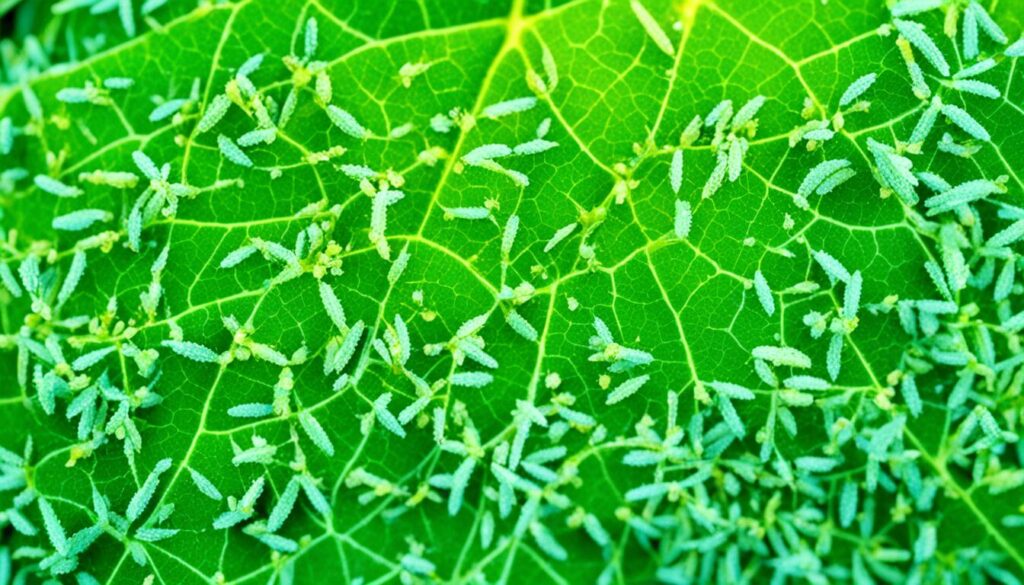
Stay alert and deal with pests and diseases quickly to keep your indoor plants healthy. Early detection and the right treatment are crucial for plants that look great. This way, you can avoid the problem of curled leaves.
Conclusion
Your indoor plant leaves curl for many reasons, like not enough water or too much. Understanding these causes helps you fix your plants. By taking good care of them, you can keep your indoor space green and lively.
With the right knowledge, you can have beautiful houseplants that make your home look great. Fixing the main problems with leaf curling solutions ensures your plants stay healthy. This makes your indoor space calm and refreshing.
Keep an eye on your plants and be ready to change things if needed. With a bit of care, your plants will show off their beautiful leaves. Enjoy the process of taking care of your indoor plant care and see your plants flourish.
FAQ
What are the common causes of indoor plant leaves curling?
Indoor plant leaves curl due to underwatering, overwatering, low humidity, heat stress, nutrient lack, pests, and transplant shock.
How do I know if my plant is underwatered?
Look for dry, crispy leaves, a wilted look, and a dry soil surface to spot underwatering.
How can I revive an underwatered plant?
To fix an underwatered plant, water it well until the soil gets soaked and drains. Or, try the capillary method by placing the pot in water for it to absorb moisture.
Can overwatering also cause indoor plant leaves to curl?
Yes, overwatering can curl indoor plant leaves too. It happens when roots rot from too much water, stopping nutrient and water uptake.
How can I identify and treat an overwatered plant?
Overwatered plants show yellow or wilted leaves, soggy soil, and a bad smell. Fix it by removing the plant, cutting off dead roots, and repotting in better soil. Change your watering to let the soil dry a bit between waters.
How can environmental factors contribute to indoor plant leaves curling?
Dry air and high heat make plants lose moisture too fast, curling leaves. Too little or too much light also stresses plants, causing curling.
How can I address low humidity and heat stress in my indoor plants?
For low humidity, mist your plants, use a pebble tray, or get a humidifier. Move plants to cooler spots and shade during the hottest times to fight heat stress.
Can pests and diseases also cause indoor plant leaves to curl?
Yes, pests like aphids and spider mites weaken plants by eating sap, causing curling leaves. Diseases can also curl leaves as a sign.
How can I prevent and address pest infestations and diseases on my indoor plants?
Check your plants often for pests or diseases, isolate new plants, and use natural pest control like neem oil. For serious problems, you might need stronger chemicals.


